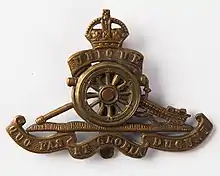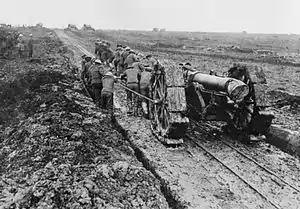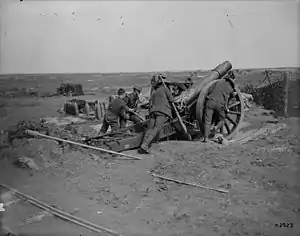68th Siege Battery, Royal Garrison Artillery
68th Siege Battery was a unit of Britain's Royal Garrison Artillery (RGA) formed in Wales during World War I. It served on the Western Front, including the Battles of the Somme and Passchendaele, and the crushing victories of the Allied Hundred Days Offensive in 1918.
| 68th Siege Battery, RGA | |
|---|---|
 Cap Badge of the Royal Regiment of Artillery | |
| Active | 9 October 1915–1919 |
| Country | |
| Branch | |
| Role | Siege Artillery |
| Part of | Royal Garrison Artillery |
| Engagements | Battle of the Somme Battle of Passchendaele Battle of the Selle |
Mobilisation
68th Siege Battery was formed under War Office Instruction 144 of October 1915 from one company of the Pembroke Royal Garrison Artillery of the Territorial Force (TF) based at Pembroke Dock in West Wales, together with an equal number of recruits from the Regular RGA.[1][2][3][lower-alpha 1] In addition, No 652 Company, Army Service Corps (ASC), was formed on 19 February 1916, as Battery Ammunition Column Motor Transport for 68th and 69th Siege Btys.[5]
The battery left the UK on 31 March 1916 and landed at Le Havre on 1 April to join the British Expeditionary Force (BEF). On 13 April it took over four obsolescent 6-inch 30 cwt howitzers from 28th Siege Bty and joined VI Corps' Heavy Artillery the following day.[3][6] Its ASC company was absorbed into the heavy artillery ammunition column on 25 April.[5]
VI Corps was part of Third Army, holding the BEF's front from Arras to Hébuterne. The gunners of 68th Siege Bty learned their trade in the Arras sector and then moved to Sailly-au-Bois to join VII Corps, which was preparing for the Attack on the Gommecourt Salient in the forthcoming 'Big Push' (the Battle of the Somme).[3][7][8][9][10]
Gommecourt
.jpg.webp)
Right Half Battery arrived at Sailly on 2 June and began digging positions in an apple orchard for the guns that arrived during the night of 7/8 June. The two guns started firing registration shots on 16 June. Left Half Battery began digging in on 15 June and opened fire on 25 June. The battery formed part of 35th Heavy Artillery Group (HAG), but before the battle was attached to 47th HAG, which formed a sub-group under 35th HAG's command. The group's main role was to use the high-angle fire of its howitzers to bombard German trenches and strongpoints facing 56th (1/1st London) Division's attack frontage on the south side of the Gommecourt salient. The specific targets assigned to 68th Siege Bty along with the 9.2-inch heavy howitzers of 91st and 94th Siege Btys were the strongpoints at Gommecourt Cemetery and the eastern edge of The Maze, the trenches codenamed Mess, Mere, Meed and Meet running along the top of the ridge into Rossignol Wood, and the communication trenches codenamed Exe, Ems, and Epte.[3][6][11] However, a shortage of shells for the new 6-inch 26 cwt howitzers meant that 68th Siege Bty with its old 30 cwt howitzers also had to take on much of the programme allotted to 88th and 98th (Canadian) Siege Btys of 47th HAG preparing for 46th (North Midland) Division's attack on the north side of the salient, where the 68th had no observation post (OP) of its own.[12]
The bombardment programme was spread over five days, U, V, W, X andY before the assault was launched on Z day.[13] 68th Siege Bty opened fire on V day (25 June), but the trench bombardment and barbed wire-cutting[lower-alpha 2] was unsatisfactory because ground mist prevented observation and the BE2c observation aircraft of No 8 Squadron Royal Flying Corps that was supposed to be spotting fall of shot was out of contact for much of the day. Most of the battery's firing was blind 'searching and sweeping' fire on 88th Siege Bty's behalf. No 2 Gun suffered a premature burst, which wounded five of the detachment, though two of them remained on duty. W Day was much the same, Maj Mayne complaining that he had no aerial observation (though there were two BE2cs in the air all day), and the battery's OP was itself under heavy shellfire. Two salvoes of German Shrapnel shells burst near the battery without causing casualties. Ammunition supply was also a problem because the track of the Decauville light railway delivering shells to Sailly collapsed in the wet weather. On X day the battery fired its full programme, blind in the morning because of the poor communications with the aircraft, but with good observed shooting in the afternoon. Because of poor weather on Y day, the attack was postponed for two days, and the additional days (Y1 and Y2) were used for further bombardment. On Y1 the battery had easy observation and reported good shooting, though ammunition was short and the aircraft's wireless broke down.[15][16] Overall, the damage caused to the German positions was insufficient to suppress the defenders.[17]
On Z Day (1 July), the entire artillery supporting 56th Division fired a 65-minute bombardment of the German front, starting at 06.25. At 07.30 the guns lifted onto their pre-arranged targets in the German support and reserve lines as the infantry got out of their forward trenches and advanced towards Gommecourt. From 07.50 68th Siege Bty maintained a slow rate of fire on Anna communication trench from Point 147 to Rossignol Wood. At first all went well for 56th Division. Despite casualties from the German counter-bombardment on their jumping-off trenches, the smoke and morning mist helped the infantry, and they reached the German front line with little loss and moved on towards the second and reserve lines. The artillery OPs reported the signboards erected by the leading waves to mark their progress. However, the OPs themselves came under attack from the German guns, which laid a Barrage across No man's land preventing supplies and reinforcements from reaching the leading infantry waves who had entered the German trenches. At 08.44, 35th HAG ordered Left Section of 68th Siege Bty to change target to Gommecourt Wood to support 46th Division's failing attack, and for the rest of the day the guns were switched between the wood and Anna, Etch and Epte trenches. By midday, the Germans were launching concerted counter-attacks from all directions, including Epte, Ems and Etch trenches, and by mid-afternoon 56th Division's slight gains were being eroded. All the remaining gains had to be abandoned after dark.[18][19][20][21]
VII Corps' costly attack was only a diversion from the main BEF attack further south, and was not renewed after the first day. 68th Siege Bty was transferred to 21st HAG with Fourth Army, which continued the offensive throughout the summer and autumn. On 13 September the battery was rearmed with four modern Vickers-built 6-inch 26 cwt howitzers. It was switched back to Third Army with 50th HAG on 29 October, and then to First Army with 70th HAG on 29 November.[6][22]
Later War

It was the policy to switch batteries between HAGs frequently as the situation demanded. On 26 January 1917, 68th Siege Bty moved to 76th HAG, then to 24th HAG with Second Army on 16 February 1917, and back to 50th HAG again on 23 February 1917.[6][22] These were all in relatively quiet sectors. On 6 August 1917 the battery was joined by a section from the newly-arrived 402nd Siege Bty, and was made up to a strength of six howitzers.[2][6] The battery moved to 98th HAG with Second Army on 30 October 1917, in time for the final 10 days of action in the Third Ypres Offensive. Second Army had taken over direction of the faltering offensive and fought a series of successful battles employing massive weight of artillery. But as the offensive continued with the Battle of Poelcappelle and First and Second Battles of Passchendaele, the tables were turned: British batteries were clearly observable from the Passchendaele Ridge and were subjected to counter-battery (CB) fire, while their own guns sank into the mud and became difficult to move and fire. To be able to supply them with ammunition the heavy guns had to stay strung out one behind the other along the few available roads, making them an easy target.[23][24][25][26]
Second Army HQ was sent to the Italian Front shortly afterwards, and the battery moved to 89th HAG 10 December 1917 as it was about to join Third Army[6][22] By now HAG allocations were becoming more fixed, and on 1 February 1918 they were converted into permanent RGA brigades. For the rest of the war the battery was part of 89th (8-inch Howitzer) Bde, RGA, along with one 8-inch howitzer battery and two other 6-inch howitzer batteries.[6][22][27] Third Army was partially involved in defending against the German Spring Offensive in 1918, then 89th Bde RGA transferred to Fourth Army on 1 May.[22]
Hundred Days Offensive

Fourth Amy played a leading role on the Allied Hundred Days Offensive starting on 8 August, and by early October it had closed up to the River Selle. 89th Bde was assigned to XIII Corps' attack on this line, which was accompanied by a massive fireplan. Preparations began on 11 October and on 13 October the heavy howitzers began bombarding important localities chosen by Corps HQ. On 15 and 16 October mist and rain disrupted air reconnaissance, but Zero for the Battle of the Selle was fixed for 05.20 on 17 October. 50th (Northumbrian) and 66th (2nd East Lancashire) Divisions made an assault crossing of the river covered by an artillery barrage and pushed ahead. The first day of the battle went well, one German counter-attack being broken up when all available guns were turned onto it. Steady progress was also made on the second and third days as Fourth Army closed up to the Sambre Canal.[28][29][30]
Much of Fourth Army went into reserve after the Selle, and 89th Bde and 68th Bty were with Fifth Army by the time of the Armistice with Germany.[27][31]
68th Siege Bty was disbanded in 1919.[2] (A new 68th Bty, RGA, was formed on 16 April 1919 from the wartime 21st Heavy Bty.[32])
Footnotes
Notes
- War Office Instructions, October 1915
- Frederick, p. 702.
- MacDonald, Pro Patria, pp. 188–9.
- Monthly Army List, August 1914.
- Young, Annex Q.
- 'Allocation of Siege Batteries RGA', The National Archives (TNA), Kew, file WO 95/5494/4.
- Becke, Pt 4, pp. 92–8.
- Becke, Pt 4, p. 177.
- MacDonald, Pro Patria, p. 161.
- MacDonald, Offensive Spirit, p. 106.
- MacDonald, Pro Patria, p. 181; Appendix 1.
- MacDonald, Lack of Offensive Spirit, pp. 219–21.
- Edmonds, 1916, Vol I, p. 299.
- MacDonald, Lack of Offensive Spirit, p. 225.
- MacDonald, Pro Patria Mori, pp. 198–9.
- MacDonald, Lack of Offensive Spirit, pp. 225–6, 243–4, 248–9, 254–6, 262.
- Edmonds, 1916, Vol I, p. 460.
- Edmonds, 1916, Vol I, pp. 462–4, 471–3.
- MacDonald, Lack of Offensive Spirit, pp. 423–4.
- MacDonald, Pro Patria Mori, pp. 528–30.
- Ward, pp. 37–44.
- 'Allocation of HA Groups', TNA file WO 95/5494/1.
- Becke, Pt 4, pp. 84–5.
- Edmonds, 1917 Vol II, pp. 327–30, 374-77.
- Farndale, Western Front, pp. 211–13.
- Wolff, pp. 223–35, 249–51.
- Farndale, Western Front, Annex M.
- Blaxland, pp. 251–2.
- Edmonds & Maxwell-Hyslop, pp. 295–8, 308–15, 318.
- Farndale, Western Front, pp. 307–9.
- Edmonds & Maxwell-Hyslop, pp. 325.
- Frederick, pp. 700, 730.
References
- Maj A.F. Becke,History of the Great War: Order of Battle of Divisions, Part 4: The Army Council, GHQs, Armies, and Corps 1914–1918, London: HM Stationery Office, 1944/Uckfield: Naval & Military Press, 2007, ISBN 1-847347-43-6.
- Gregory Blaxland, Amiens: 1918, London: Frederick Muller, 1968/Star, 1981, ISBN 0-352-30833-8.
- Brig-Gen Sir James E. Edmonds, History of the Great War: Military Operations, France and Belgium, 1916, Vol I, London: Macmillan,1932/Woking: Shearer, 1986, ISBN 0-946998-02-7.
- Brig-Gen James E. Edmonds, History of the Great War: Military Operations, France and Belgium 1917, Vol II, Messines and Third Ypres (Passchendaele), London: HM Stationery Office, 1948//Uckfield: Imperial War Museum and Naval and Military Press, 2009, ISBN 978-1-845747-23-7.
- Brig-Gen Sir James E. Edmonds & Lt-Col R. Maxwell-Hyslop, History of the Great War: Military Operations, France and Belgium 1918, Vol V, 26th September–11th November, The Advance to Victory, London: HM Stationery Office, 1947/Imperial War Museum and Battery Press, 1993, ISBN 1-870423-06-2.
- J.B.M. Frederick, Lineage Book of British Land Forces 1660–1978, Vol II, Wakefield: Microform Academic, 1984, ISBN 1-85117-009-X.
- Alan MacDonald, Pro Patria Mori: The 56th (1st London) Division at Gommecourt, 1st July 1916, 2nd Edn, West Wickham: Iona Books, 2008, ISBN 978-0-9558119-1-3.
- Alan MacDonald, A Lack of Offensive Spirit? The 46th (North Midland) Division at Gommecourt, 1st July 1916, West Wickham: Iona Books, 2008, ISBN 978-0-9558119-0-6.
- Maj C.H. Dudley Ward, The Fifty Sixth Division, 1st London Territorial Division, 1914–1918, London: John Murray, 1921/Uckfield: Naval & Military Press, 2001, ISBN 978-1-843421-11-5.
- War Office, Instructions Issued by The War Office during October, 1915, London: HM Stationery Office.
- Lt-Col Michael Young, Army Service Corps 1902–1918, Barnsley: Leo Cooper, 2000, ISBN 0-85052-730-9.